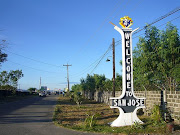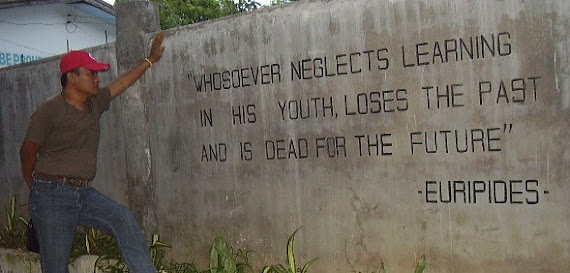The
Lumintao Bridge is at the verge of falling down thus pulling down our local economy, the quality of government service and the peoples’ trust and confidence with authorities. Specifically
those top brasses at the Department of Public Works and Highways (DPWH) in the province.
As
early as October last year, the riding public from all walks of life already
informed the authorities about the situation of Lumintao Bridge. For their part,
both the municipalities of Rizal and Calintaan sought the attention of the
Provincial Government and the DPWH-Mindoro Occidental District Engineering
Office but no specific major intervention was made except for placing warning
signs and barriers made up of twigs atop the structure. As nobody is displaced in the area then to mitigate
violations, heavily loaded trucks and heavy vehicles continue to ignore the sign and the thorny barrier. Until
the rainy season was officially declared and flooding occurred due to incessant
rain brought about by southwest monsoon. The bridge continues to tilt and move
downward on the downstream side of the river.
In
his letter dated June 19, 2018, DPWH District Engineer Josefino M. Melgar, Jr.
informed the public, specifically the local government units, that the agency
is temporarily closing the bridge “to ensure the safety of the travelling
public and to avoid more damages to Lumintao Bridge.” In a meeting with the
Sangguniang Panlalawigan live-streamed at Radio Mindoro Network Facebook Page on
that same day and in response to the query of SP Sonia C. Pablo, who hails from
Rizal town and doing her oversight function as legislator from the Second District, Engr. Danilo S. Muniz, head of maintenance in San Jose District,
assured the august body that the bridge will be passable in just a matter of 5
days. It is now on its 8th day since it was closed. Bokal Pablo, needless to say, wants an immediate and effective solution to the problem.
Not to dwell on the hellish situation atop the troubled infrastructure affecting the travelling public, it hampers the delivery of services by the local governments, our economy in general and it epitomizes the neglect of the agency whose main thrust is to provide and manage quality infrastructure facilities and services that are responsive to the needs of the people in the pursuit of development. This is Lumintao Bridge’s coordinate: 12.5239857, 120.9879682. Google earth it and you will find the true score in the last few days and see it for yourself.
Not to dwell on the hellish situation atop the troubled infrastructure affecting the travelling public, it hampers the delivery of services by the local governments, our economy in general and it epitomizes the neglect of the agency whose main thrust is to provide and manage quality infrastructure facilities and services that are responsive to the needs of the people in the pursuit of development. This is Lumintao Bridge’s coordinate: 12.5239857, 120.9879682. Google earth it and you will find the true score in the last few days and see it for yourself.
The
Rizal Municipal Police Station on June 21, 2018 inquired with Engr. Melgar on
the estimated cost damage of the bridge and it is pegged at Php 35 million. No doubt,
this sorry predicament that we are into is due to both natural and man-made explanations,
rolled into one. Emergency and disaster reduction efforts were made though by
nearby local government units.
Aside
from Lumintao Bridge, it is also reported that the Pinamanaan Bridge in Barangay Mabini, San Jose is in a volatile situation too. There are also various reports from other bridges
in other municipalities that need attention. To my mind, any land development
projects like putting up and repair of bridges in flood- prone rivers need more
than civil engineering. The DPWH must get a lesson from this situation. Civil
engineers in the department and the local governments in the province should be
informed and be familiarized on storm water issues, basic hydrology and water resource
engineering. It would boil down to the problem of governance and political
vision from the lenses of the people.
As
of this moment, according to Celestino C. Aroc III, maintenance foreman for
DPWH, they are now re-channeling the river and after that, his crew could start
to erect steel poles to support the broken part down the bridge. The work is
snail-paced says many of the observers and regular passers-by.
Neglect
comes in many forms. The DPWH, as proposed by many concerned citizens, must
issue an updated, (again, updated!) inventory of bridges within Occidental
Mindoro to know the status of said infrastructures. This report is vital in the
crafting of an effective intervention plan on rehabilitation, repair and
replacement of a particular bridge. There is no substitute to general
information and public knowledge. The people have the right to know. The Occidental
Mindoro District Office of DPWH, as of 28 December, 2016, Lumintao Bridge (B00084MR)
is posted as a permanent and concrete bridge with a “Fair” rating.
There
could be no neglect if proper planning on maintenance was enacted in the most fitting
time. I was informed that the root of the problem started when a huge timber
was stuck at one foot of the bridge creating a strong current that made the
foot rickety. The timber dawdled there for months hammered constantly by the
angry river during heavy rain, said some locals. Logic dictates that in the
planning, the repairs are logically to be implemented during the so-called dry season
which is the most conducive season of the year for such activity. Why is that every
year construction and maintenance work on the roads and bridges started just before
the onset of the monsoon? It is the poor who suffered most.
This
is the best lesson we learned: as we value the appearance of the Lumintao
Bridge’s structures we must understand that it should function not as mere utility. And in this
particular case, it became an epitome of poor keenness, if not neglect…
-------
(Photo: from
Divine Pascual Martizano’s FB account)









